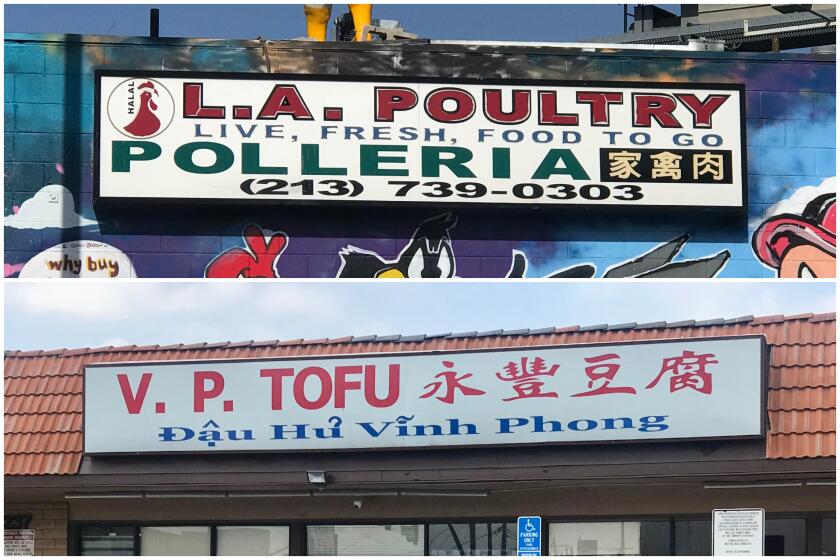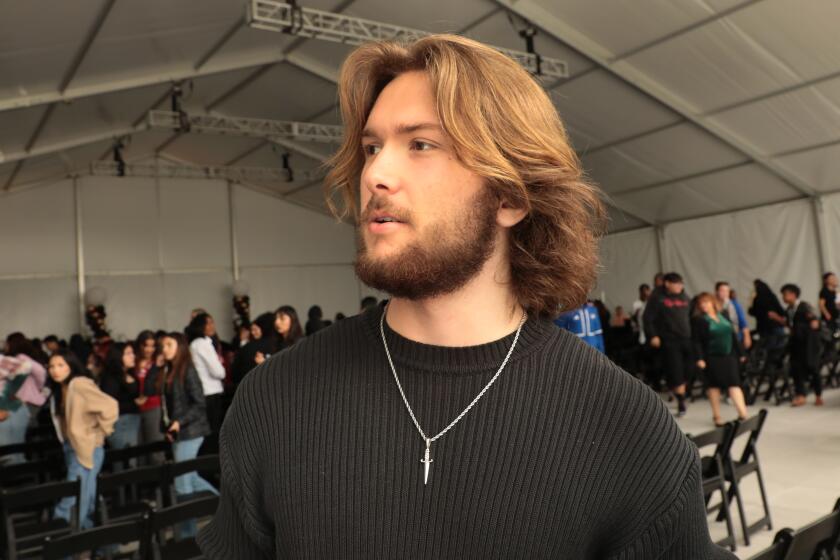How Do You Beat a Phantom?
Few candidates for mayor of Los Angeles in modern times have figured out what every pulp-fiction writer on L.A. instinctively knows: The city doesn’t exist for most of us as a geographic entity, but only in our imaginations. A failure to grasp this elemental truth, as Tom Hayden is discovering, makes it nearly impossible to penetrate the city’s bland civic culture and mount a riveting campaign. The reasons lie in both the convergence of history and geography, and in the growing symbiosis between politics and television.
Los Angeles is less a city than a series of indistinct zones lacking any neighborhood cohesion or overarching identity. Patched together by carnivorous annexation, L.A., moreover, has vast, integral chunks of its greater geography carved up and separated off into other cities. Beverly Hills, West Hollywood and Santa Monica, for example, are the most identifiable parts of the huge urban landscape known as West Los Angeles; yet, they and their politically sophisticated and activist citizens are not part of Los Angeles’ electorate.
Intensifying this sense of disunity is the city’s municipal heart--downtown. All but deserted at night, during the day it appears inhabited solely by cops, lawyers, politicians, journalists, civil servants, office workers and the poor and the homeless. For the rest of the city’s residents, downtown is that place they pass on the freeway to and from work.
The progressives share responsibility for making it difficult to run any kind of compelling mayoral campaign. With their high-minded notion of nonpartisan elections, they squeezed all the passion and excitement out of mayoral campaigns.
As if to complement their work, they also ensured that the position of mayor became deadly gray. Fed up with corrupt mayors exploiting the system, they reformed the City Charter in 1925, limiting the mayor’s powers while giving everybody else either greater political authority or insulation from political accountability.
The mayor’s stature and power, and thus voter interest, have been further diluted by the fact that social services, as well as a myriad other governmental functions--from physical planning to running the jails--are controlled by the county, not the city. The school system, too, is entirely independent of the mayor, without even the fiscal oversight that a mayor of a city like Chicago enjoys.
What’s left for an L.A. mayor are the bully pulpit, the powers of persuasion and manipulation behind the scenes. Tom Bradley, in his first two terms as mayor, used all three brilliantly. Richard Riordan, the multimillionaire mayor, is the master of the back-room deal and has enough independent wealth to buy the television advertising that makes it at least appear he has vision.
But to be successful, a mayoral candidate must first find the unifying idea that appeals to large numbers of people. Only then can he or she generate enthusiasm. In New York, a far easier city to stir up than Los Angeles, Ed Koch did it by personifying the city’s style and joie de vivre. So did Rudolph W. Giuliani, by telling an electorate disgusted with anarchy and crime that he could make the city work again.
There have also been L.A. mayors who have stirred things up through the power of an idea. Fletcher Bowron, in 1938, represented a genuine grass-roots movement that successfully recalled the scandal-plagued Mayor Frank L. Shaw. He campaigned to clean up the corrupt political system and reform the equally corrupt Los Angeles Police Department. Once in office, Bowron fulfilled his promises.
In 1961, Sam Yorty had an idea: wrest control of City Hall from the downtown business interests and the Committee of Twenty-five, and give it to the emerging suburban communities in places like the San Fernando Valley. He followed through on very little, but he did ignite people’s interests.
Then came Bradley with his grand, towering concept: The old order has passed, integration can work and the day of the Jew and the African American and of other minorities as fully participating citizens has arrived. Bradley delivered, at least in part, permanently opening up city jobs and city government to the people constituting the new Los Angeles.
Even Riordan, perhaps the least charismatic major California politician since George Deukmejian lulled the state to sleep, had a message in his 1993 campaign: Hire more cops. It wasn’t much as visions go, but as far as the public could tell, it was more than his opponent Mike Woo was offering.
This year, we have Hayden trying to unseat Riordan. Hayden is a vigorous candidate. Yet, despite being an articulate, experienced politician of courage and ideas, Hayden has delivered no overarching rationale, as did Bowron, no call to local self-interest, as did Yorty, no unifying message, as did Bradley, not even an appeal to fear, as did Riordan. Nothing, in short, to rally around.
As a result, Hayden has failed to win the vocal support of Hollywood liberals, and of much of the black and brown leadership, as Bradley managed to do. Nor have grass-roots activists and progressive clergy coalesced around him, as they rallied around Bowron. Nor has he been able to connect the dots between a predominately liberal City Council, a rejuvenated local labor movement headed by a young insurgent Latino leadership and liberals worried about a high-handed militaristic LAPD that refuses to be reformed.
Only within the black community has Hayden’s campaign somewhat resonated--and that has been more the result of Riordan’s behind-the-scenes manipulation of Police Chief Willie L. Williams’ ouster than anything Hayden has said or promised.
Thus, in contrast to Bradley’s defeat in 1969, Hayden has even failed to set himself up as the odds-on favorite four years from now, when Riordan is unable to run again because of term limits.
Part of Hayden’s problem, of course, is that he lacks a significant campaign war chest for television advertising, and thus has been extremely constricted in getting his message out in the medium that matters most. At the same time, local television news, in a stunning display of cynical, bottom-line greed, disregarded the commonweal and refused to air or rebroadcast the one debate with Hayden that Riordan had agreed to. It eventually aired on only one Westside cable station.
To make matters worse, Hayden is pitted against a phantom mayor, a man so deliberately invisible that at times it’s hard to believe he actually exists. It’s difficult for Hayden or anyone else to draw a bead on such a target.
All these factors, along with Hayden’s penchant to go his own way and to not craft a simple message, have robbed Los Angeles of what could have been an exciting race: immigrant Los Angeles, minority Los Angeles, liberal Los Angeles and working-class Los Angeles against corporate L.A. But Hayden hasn’t framed it that way. Or if he has, I haven’t seen it on TV.
More to Read
Start your day right
Sign up for Essential California for news, features and recommendations from the L.A. Times and beyond in your inbox six days a week.
You may occasionally receive promotional content from the Los Angeles Times.


![Stephanie Lazarus, a Los Angeles police detective charged with capital murder in the 1986 slaying of her ex-boyfriend's wife pleaded not guilty during her arraignment in Los Angeles Superior Court Monday morning, July 6, 2009. (AP Photo/Al Seib ,Pool)]](https://ca-times.brightspotcdn.com/dims4/default/189ca94/2147483647/strip/true/crop/2400x1605+0+76/resize/320x214!/quality/75/?url=https%3A%2F%2Fcalifornia-times-brightspot.s3.amazonaws.com%2F65%2Fe0%2F8228b5b44c0da5be07c48647ce71%2Fdetective-killing.JPEG)



